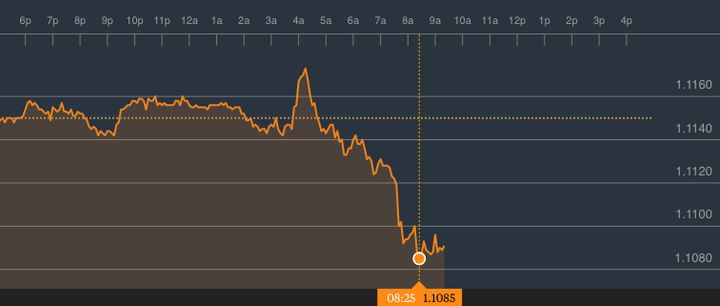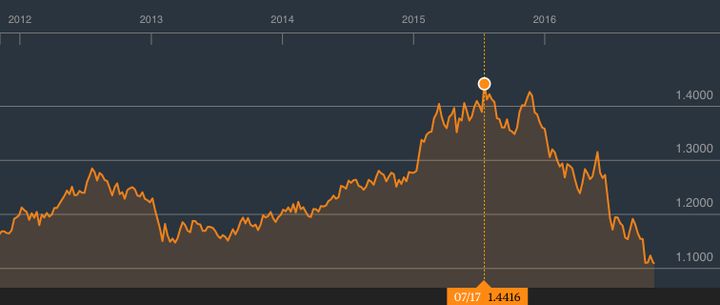Manufacturing output remained “on a firm footing” last month as the plunging pound boosted exports, but caused costs to rise at their fastest pace for nearly 25 years.
The closely watched Markit/CIPS UK Manufacturing purchasing managers’ index (PMI) said output hit 54.3 in October, down from 55.5 in September, and below economists’ expectations of 54.4
A reading above 50 indicates growth.
Despite easing back from September’s two-year high, output was still well above the long-running average of 51.5.
Sterling has fallen nearly 20% against the US dollar and 15% against the euro since the EU referendum.
On Tuesday morning the pound to Euro exchange rate fell to 1.1085, lower than after last week’s plunge in the wake of the Government winning two cases at the High Court in Belfast challenging its right to trigger Article 50.

HSBC has predicted the pound will hit parity against the Euro by the end of the year meaning a 1:1 exchange rate, bad news for holidaymakers.
For comparison, around this time last year the rate was 1:1.4 meaning a potential difference of 40p for every pound you take abroad.

Here’s a video explaining imports/exports/exchange rates (just imagine they’re British and talking in pounds).
Theresa May has she will start Brexit “no later than the end of March”.
She told delegates at the Tory conference earlier this month that she plans to curb immigration, “stoking speculation the nation is headed toward a so-called hard Brexit - with limited access to the EU’s single market” Bloomberg reported.
Against the dollar, the forecast is also gloomy with HSBC predicting a fall to $1.10
The PM’s lurch to a “hard Brexit” stance on EU withdrawal risks destroying Britain’s hopes of remaining an open economy, the head of the CBI has warned.
The PMI report said the slump since the Brexit vote had helped manufacturers rake in more export orders from America, China and the EU.
However, it added that the currency weakness had also ramped up import prices and the cost of products linked to dollar-denominated commodities such as oil.
Rob Dobson, senior economist at IHS Markit, said: “The UK manufacturing sector remained on a firm footing in October and should return to growth in the fourth quarter.
“The main topic of the latest PMI survey was, however, the impact of the sterling depreciation on manufacturers, reports the Press Association.
“On the positive side, the boost to competitiveness drove new export order inflows higher, providing a key support to output volumes.
“The down-side of the weaker currency is becoming increasingly evident, however, with increased import prices leading to one of the steepest rises in purchasing costs in the near 25-year survey history.
“Around 90% of companies offering a reason for increased costs made some reference to the sterling exchange rate.”
The report underscored the manufacturing sector’s resilience to the rising uncertainty since Britain voted to leave the European Union, with new order volumes rising for the third consecutive month.
However, purchase price inflation rose to a near six year high - reaching its fourth highest level since the survey launched in 1992 - following higher costs for energy, metals and pork.
It said pressures from inflation were also being felt at the factory gate, with average selling prices rising at the steepest pace for more than five years.
Manufacturing employment also stepped up for the third month on the bounce, with the rate of jobs growth hitting a one-year high.
Samuel Tombs, chief UK economist at Pantheon Macroeconomics, said: “The manufacturing sector has returned to a modest rate of growth now that the volatility induced by the Brexit vote has worked its way through.”
“The further rise in the input prices balance to a 69-month high suggests sharper price rises lie ahead,” he added.
“Meanwhile, we continue to expect manufacturers to struggle to capitalise on the weak pound in the near term, given the usual delays involved in finding new business, renegotiating contracts and investing in extra capacity.
“As a result, a slowdown in domestic demand likely will ensure that the recovery in the manufacturing sector disappoints over the coming months.”
It was disclosed on Thursday that the UK economy bucked expectations of a substantial slowdown in the three months after the Brexit vote thanks to a “strong performance” from the powerhouse services sector.
The Office for National Statistics (ONS) said gross domestic product (GDP) grew by 0.5% in its first estimate of third-quarter growth, down slightly from 0.7% in the second quarter, with economists pencilling in a steeper fall to 0.3%.
